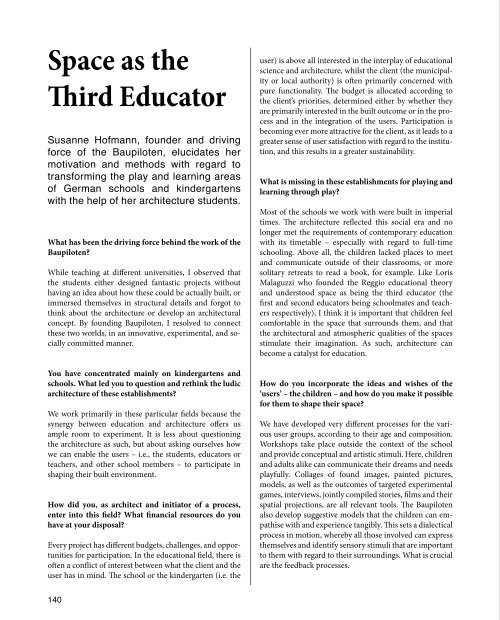Make_Shift City
ISBN 978-3-86859-223-8
ISBN 978-3-86859-223-8
Sie wollen auch ein ePaper? Erhöhen Sie die Reichweite Ihrer Titel.
YUMPU macht aus Druck-PDFs automatisch weboptimierte ePaper, die Google liebt.
Space as the<br />
Third Educator<br />
Susanne Hofmann, founder and driving<br />
force of the Baupiloten, elucidates her<br />
motivation and methods with regard to<br />
transforming the play and learning areas<br />
of German schools and kindergartens<br />
with the help of her architecture students.<br />
What has been the driving force behind the work of the<br />
Baupiloten?<br />
While teaching at different universities, I observed that<br />
the students either designed fantastic projects without<br />
having an idea about how these could be actually built, or<br />
immersed themselves in structural details and forgot to<br />
think about the architecture or develop an architectural<br />
concept. By founding Baupiloten, I resolved to connect<br />
these two worlds, in an innovative, experimental, and socially<br />
committed manner.<br />
You have concentrated mainly on kindergartens and<br />
schools. What led you to question and rethink the ludic<br />
architecture of these establishments?<br />
We work primarily in these particular fields because the<br />
synergy between education and architecture offers us<br />
ample room to experiment. It is less about questioning<br />
the architecture as such, but about asking ourselves how<br />
we can enable the users – i.e., the students, educators or<br />
teachers, and other school members – to participate in<br />
shaping their built environment.<br />
How did you, as architect and initiator of a process,<br />
enter into this field? What financial resources do you<br />
have at your disposal?<br />
Every project has different budgets, challenges, and opportunities<br />
for participation. In the educational field, there is<br />
often a conflict of interest between what the client and the<br />
user has in mind. The school or the kindergarten (i.e. the<br />
user) is above all interested in the interplay of educational<br />
science and architecture, whilst the client (the municipality<br />
or local authority) is often primarily concerned with<br />
pure functionality. The budget is allocated according to<br />
the client’s priorities, determined either by whether they<br />
are primarily interested in the built outcome or in the process<br />
and in the integration of the users. Participation is<br />
becoming ever more attractive for the client, as it leads to a<br />
greater sense of user satisfaction with regard to the institution,<br />
and this results in a greater sustainability.<br />
What is missing in these establishments for playing and<br />
learning through play?<br />
Most of the schools we work with were built in imperial<br />
times. The architecture reflected this social era and no<br />
longer met the requirements of contemporary education<br />
with its timetable – especially with regard to full-time<br />
schooling. Above all, the children lacked places to meet<br />
and communicate outside of their classrooms, or more<br />
solitary retreats to read a book, for example. Like Loris<br />
Malaguzzi who founded the Reggio educational theory<br />
and understood space as being the third educator (the<br />
first and second educators being schoolmates and teachers<br />
respectively), I think it is important that children feel<br />
comfortable in the space that surrounds them, and that<br />
the architectural and atmospheric qualities of the spaces<br />
stimulate their imagination. As such, architecture can<br />
become a catalyst for education.<br />
How do you incorporate the ideas and wishes of the<br />
‘users’ – the children – and how do you make it possible<br />
for them to shape their space?<br />
We have developed very different processes for the various<br />
user groups, according to their age and composition.<br />
Workshops take place outside the context of the school<br />
and provide conceptual and artistic stimuli. Here, children<br />
and adults alike can communicate their dreams and needs<br />
playfully. Collages of found images, painted pictures,<br />
models, as well as the outcomes of targeted experimental<br />
games, interviews, jointly compiled stories, films and their<br />
spatial projections, are all relevant tools. The Baupiloten<br />
also develop suggestive models that the children can empathise<br />
with and experience tangibly. This sets a dialectical<br />
process in motion, whereby all those involved can express<br />
themselves and identify sensory stimuli that are important<br />
to them with regard to their surroundings. What is crucial<br />
are the feedback processes.<br />
140


















